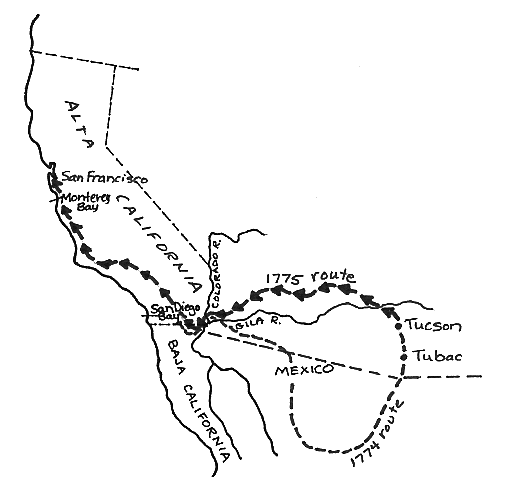| ||||
|
| ||||
|
JUAN
BAUTISTA DE ANZA
 Lived:
1735-?1788
Lived:
1735-?1788
Explored California in: 1771-1775
Exploring for: Spain
Explored: by land from Mexico to San Francisco
The first party of emigrants
to Alta (Upper) California arrived in 1775, having traveled overland from
Sonora,
EARLY HISTORY
Juan Bautista de Anza was born
in Mexico of Spanish parents in 1735. His father and grandfather before him
had been frontier military captains in Sonora,
BACKGROUND
Captain Anza had long thought that a land route would be safer than the dangerous sea voyage up the Pacific Coast. The Baja (Lower) California land route taken by Father Serra and Governor Portolá in 1769 was no longer considered safe. The missions there were poor and could not give aid to travelers. The Indians there were not friendly. Supplies to the missions founded in Alta California had to go by sea, a perilous trip.
Anza had first presented his
plan for a new route in 1769. In 1771 a new viceroy,
Antonio de Bucareli, came from
ANZA’S JOURNEYS
In January 1774 Anza and a group of 34 men left the presidio at Tubac and headed west. With them as a guide was Father Garcés. When the group reached the Colorado River, they were ferried across on tule-reed rafts by the Yuma Indians.
Father Garcés left the group in the desert. Their guide from there on was Sebastián Tarabal, an Indian who had previously lived at Mission San Gabriel in California. Now Anza’s party wandered in the desert for ten days, unable to find their way. Finally Tarabal recognized some landmarks and brought them safely across what is now called the Imperial Valley, along the eastern slopes of the mountains and the Borrego Valley, then across more mountains into the Cahuilla Valley. They reached Mission San Gabriel on March 22, 1774.
From San Gabriel, Anza’s party went up the central valley to Monterey. Anza then returned to Tubac where he made a full report on how a colony of settlers could be established in northern California. Bucareli was delighted with Anza and promoted him to lieutenant colonel. Anza began plans for his colonizing expedition.
Anza’s second expedition left
in October 1775 from Horcasistas,
Most people in
With such a large group, progress was slow. They spent Christmas 1775 in the mountains. It is to Anza’s credit as leader that only one person died on the 1,500-mile trip. That was a woman giving birth to a child. Several children were born during the 165-day journey, so Anza arrived in Monterey with a larger group than when he started.
The route they followed was much like Anza took in 1774. Again, Garcés was their guide as far as the Colorado River. When they reached Mission San Gabriel, Anza heard that the mission in San Diego had been attacked by Indians. He made a sidetrip there, to help defend the padres.
It was a rainy March 10, 1776, when the group of settlers reached Monterey. Anza went on ahead to San Francisco and picked out the site for the presidio and mission. The site for the presidio was the point at the northern tip of the peninsula, just by the Golden Gate. The mission site was about three miles to the southeast.
A disagreement arose between Anza and California governor Rivera, who was not in favor of the proposed settlement. After making an exploratory trip down the San Francisco peninsula and around San Francisco Bay, Anza left the area. It was up to his second-in-command, Lt José Joaquín Moraga, to bring 193 of the new settlers on from Monterey to San Francisco. The new presidio was dedicated on September 17, and the mission (called San Francisco de Asís) on October 9, 1776.
We know more about this expedition because Father Pedro Font, a Franciscan missionary who was with the group, kept a diary.
WHAT HE ACCOMPLISHED
Anza completed the opening of
an overland route from
LATER YEARS
Anza returned to